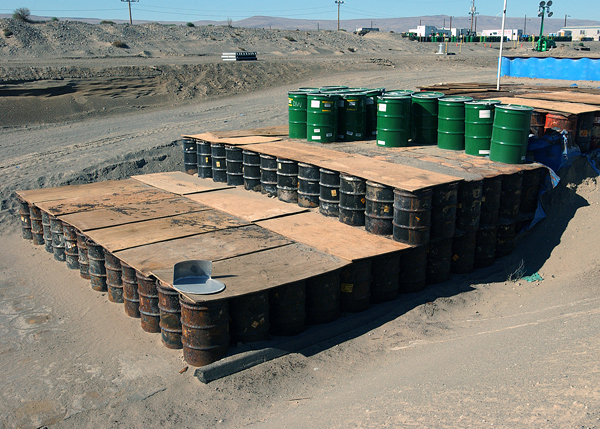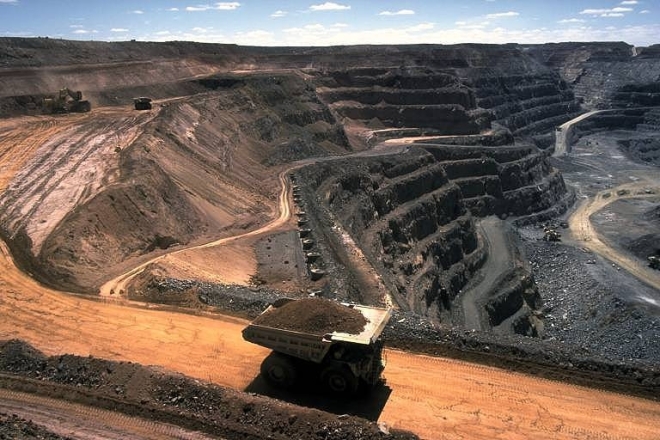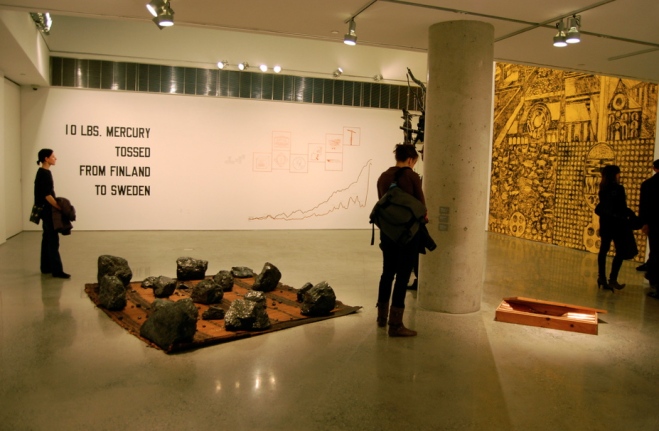FOP/smudge studio announces a CALL FOR SUBMISSIONS for a proposed edited collection of brief writings and visual essays, tentatively entitled “Making a Geologic Turn.” The book, which we are now proposing to publishers, is part of our larger project to both document and make something more of the geologic turn in contemporary cultural practices (see below).
what we mean by “making a geologic turn”
Until recently, the word “geologic” referred simply and directly to the science of geology–the study of the origin, history, and structure of the earth. But that’s changing. (We reported our first whiff of this change in a recent FOP post: geologic time is now). Something is happening to and with the ways people take up “the geologic,” and that’s intriguing to us as Friends of the Pleistocene.
Contemporary artists, popular culture producers, and even philosophers are adding new layers of meaning and sensation to “geologic.” Humans seem to be sensing (in new ways?) that the geologic is not only an area of scientific study–it’s also a condition of daily life.
 Nevada Forest Fire, 2005, image NASA Johnson Space Center – Earth Sciences and Image Analysis (NASA-JSC-ES&IA)
Nevada Forest Fire, 2005, image NASA Johnson Space Center – Earth Sciences and Image Analysis (NASA-JSC-ES&IA)
At some point in the recent past, the geologic became sense-able (with new physical intensity and from new angles of thought) as a situation that we live within, not just something “out there” that we study.
Contemporary visual culture, art practices, ideas and values are now signaling the fact that the geologic is a force in contemporary life. There seems to be a growing recognition that the geologic, both as a material dynamic and as a preoccupation, shapes the “now” in ever more direct and urgent ways, through geologic forces such as: deep time, slow accumulations and metamorphoses of the world’s materiality, tectonic plate movements, erosion and displacement of landforms, dramatic earth reshaping events, geo-bio interactions. These are forces to be reckoned with existentially, creatively, and pragmatically as humans work to meet the fact that our species is both vulnerable to geologic forces and also has become a geologic force on the planet.
You could say the geologic has become a condition of contemporaneity.
And that brings us to contemporary art practices. One definition of contemporary art is “art created within the conditions of contemporaneity.” As if embodying that definition, FOP and other artists are making work within the geologic as a condition of our present time.
Many contemporary artists now locate their work primarily within the situation of the geologic–within the jostling and unstable physical, social, political, and economic situations that arise from and act back upon geologic materialities and forces. And they actualize their inspiration, motivation, materials, and gestures there. The result is a growing body of aesthetic works and practices that plumb the geologic depth of “now.”
If we were to say what’s propelling this geologic turn in our own work, and more broadly within visual culture, we’d point in at least two directions.
First, we’d cite recent “natural” and human-made events, some unprecedented in scale and consequence. These seem to have compounded–both actually and within human consciousness–to lay bare the reality of just how deeply human life is embedded in the “brute materiality of the external world”–in the very “stuff” of the geologic.
A few examples: the discovery in 1997 of The Great Pacific Garbage Patch; the 2004 Indian Ocean earthquake and tsunami; Hurricane Katrina (2005); the 2010 eruption and disruption of Eyjafjallajökull; the 2010 Haiti Earthquake; increasing awareness of and preparedness efforts for the long overdue “big one” along the San Andreas Fault in California; ever-clearer signs of climate change both man-made and earth-made; recent “near misses” of earth by asteroids; growing stockpiles of high level nuclear waste and the urgent attempts to design ways to contain it–within the geologic–for up to 1 million years; the 2010 oil spill in the Gulf of Mexico; geologic-scale engineering projects capable of altering planetary dynamics, such as the Three Gorges Dam in China and carbon sequestering.
 DOE image, retrieval of buried nuclear waste at Hanford, 2005
DOE image, retrieval of buried nuclear waste at Hanford, 2005
Second, we’d point to new developments in human thought and culture. These include new scientific understandings of geologic dynamics–especially the deep interplays between the geo and the bio; shifts in popular consciousness about the relation of the human to the geo; emerging philosophical concepts that use the geologic as metaphor, model, and inspiration for thinking about space, time, and change; radically new insights about our own evolution and existence as the result of an immensely long process of geologic time; and qualitatively new ways the humans experience time and space on planet earth.
These new ways of making sense of the geologic are being made thinkable and possible by new technologies and unprecedented lived experiences. For example:
New tools for visualizing the geologic may have precipitated the current turn from seeing the geologic as an area of scientific study that is abstract at best (nerdy hobby at worst) to experiencing the geologic vividly as a situation of daily life. Perhaps the turn began in 1972, on the day that humans first saw the “blue marble” photograph of earth taken by Apollo 17 astronauts from 28,000 miles out. Our abilities to visualize Earth as a wholly interconnected and dynamic geo-bio system have grown only more acute, refined, and now even interactively palpable thanks to Google Earth. Today, dynamic imaging technologies allow us to “see” and “sense” unimaginably slow and vast geologic dynamics as “flows.” Data animations make geo-forms such as mountains and deserts perceptible as motion through time.
Because of such vivid experiences–first hand, mediated, and imagined–it’s becoming increasingly possible, even necessary, for humans to further heighten our abilities for sensing geologic time. In the 1980s, word started getting out that the geologic conditions of life on earth can be–and have been–transformed in an instant: dinosaurs probably went extinct because of anasteroid impact. Today, some scientists think dinosaurs were wiped out by volcanic eruptions in India. Regardless, their disappearance happened fast and most likely because of geologic events that were planetary in scale. Journalists and Hollywood filmmakers are peaking audiences’ curiosities–and even adding to the scientific knowledge of laypersons–about very real (past and future) catastrophic geologic events. Scientific facts about how the geologic is capable of throwing our entire species into a crisis of existential risk are now part of pop culture (see the movie 2012 for a special effects version of everything from Noah-scale tsunamis to the movement of tectonic plates to the periodic and believed-to-be-overdue geomagnetic reversal of the earth’s poles).
 Coal mine, image Stephen Codrington. Planet Geography 3rd Edition (2005) [1]
Coal mine, image Stephen Codrington. Planet Geography 3rd Edition (2005) [1]
Perhaps most starkly, geologic time is beginning to have applied, material meaning for non-geologists. Not all that long ago, geologic resources seemed to be infinite. No nuclear waste needed to be stored. Carbon emissions didn’t exist. And the oceans contained zero tons of plastic. Two hundred years ago, concerns about what the planet might be like in 1000 years seemed irrelevant. No longer. In the face of rapid planetary-scale change, much of which has been human designed, today’s humans are confronted with realizing that life on earth hasn’t been like “this”, or looked like “us” for long at all. Humans seem to be having first inklings of the reality that geologic time hasn’t been composed of us–though we are composed of it. We (modern, Western people) are realizing all over again that our species’ existence is incredibly recent–that the human is a mere blip in geologic time. The sense of ourselves as a “blip” is only reinforced by the fact that “we” aren’t likely to be here much longer: most mammalian species last only one or two million years at the most, and the genus homo has already been around for almost 2.5 million years.
The internet and globalization (global flows and exchanges of information, human beings, manufactured products and earth materials) are radically transforming human experiences of time and space on earth. Philosophers and popular culture producers alike ponder the consequences for how humans sense and making meaning of time and space–including what it means to have a body. New, lived experiences of time open humans to evolving new ways to sense geologic time.
What we will make of our growing abilities and needs to sense geologic time, and what they will make of us, is a new and starkly different possibility. Already, in some realms of regional and urban “planning,” designing for geologic or “deep time” has become a design specification: deep geologic repositories for nuclear waste require engineers to plan for one million years into the future, and regional planners now actually consider what it might mean to design for the fact that the next ice age is a pretty sure thing.
 Rising Currents exhibition entrance MoMA, Photo: Jason Mandella
Rising Currents exhibition entrance MoMA, Photo: Jason Mandella
Most recently, thanks to transdisciplinary exchanges across traditional fields of science, it’s becoming difficult for geologists and biologists to distinguish between the “brute materiality” of geology’s “external world” (rocks, minerals, mountains) and the soft, “inner” worlds of biology’s living things. According to current science-based stories about life, earth, and life on earth, we humans are walking rocks–we are actually composed of geologic elements such as calcium, iron, phosphorous; from humans to lichen, comparatively tiny living organisms are key players in monumental geologic processes (the earth would have a completely different geologic self if there were no life on it); and the geologic must now be taken into account in any concept of “the environment.” Best sellers that help us think across biology, geology, and environmental sciences, such as “The World Without Us,” fuel another growing realization about deep time: while the human species can’t get along without the geologic, the geologic will continue on in some form or other long after we have ceased being part of it.
 “The Crude and the Rare,” curated by Saskia Bos and Steven Lam, at Cooper Union, photo Andrew Russeth
“The Crude and the Rare,” curated by Saskia Bos and Steven Lam, at Cooper Union, photo Andrew Russeth
Contemporary artists, speculative architects, and hybridized cultural producers are making work from and within these events and ideas. As part of the geologic turn, their works and processes heighten collective awareness of the geologic as a condition of contemporary life. As Friends of the Pleistocene, we draw inspiration and insight from the themes and gestures that characterize their work.
 still from Into Eternity, courtesy Michael Madsen 2009
still from Into Eternity, courtesy Michael Madsen 2009
Some of our sightings of those who are working with the geologic as a condition of contemporary life include:
Rachael Sussman’s photography project: the oldest living things in the world
Ilana Halperin’s works of “geologic intimacy” exploring the relationship between geological phenomena and daily life.
Karthik Pandiam’s Unearth at the Whitney examining relationships between the ancient and the modern.
Trevor Paglen’s Debris project, documenting orbiting space debris that will ironically outlast humankind’s presence on the planet
Lucy Raven’s photographic animation China Town
Ed Keller’s Design and Existential Risk 2010 lecture series at Parsons, The New School
David Gersten’s literary/visual work on architectonics
Geoff Manaugh’s ongoing visual research as cataloged on the BLDG BLOG
Peter Galison’s upcoming documentary on wilderness, wasteland, and nuclear “zones of exclusion”
Michael Madsen’s documentary Into Eternity on Onkalo, the world’s first deep earth repository for high level nuclear waste
Hiroshi Sugimoto’s recent show, Day After at Pace Gallery, exploring the origins of life millions of years ago.
Recent exhibition at Cooper Union, the Crude and the Rare where artists were commissioned to creatively respond to rare earth materials.
The Long Now Foundation’s ongoing programs and projects.
Brian Eno’s 2010 album Small Craft on a Milk Sea, including tracks such as Late Anthropocene and Paleosonic.
Rising Currents a 2010 exhibition at New York’s Museum of Modern Art exploring how a rise in global sea levels will affect New York City due to geologic force and event.
In addition to Making a Geologic Turn, we plan to produce an exhibition that maps the geologic turn in contemporary art and creative practices; facilitate gallery conversations and pedagogical events to discuss the ideas and works at the heart of the project; and offer an online, college-level course on the geologic turn in contemporary culture and art.





No comments:
Post a Comment
Note: Only a member of this blog may post a comment.